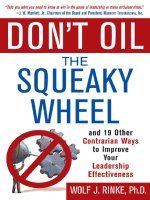sloan - don't blame the shorts; why short sellers are always blamed for market crashes and how history is repeating itself (2010)
Bạn đang xem bản rút gọn của tài liệu. Xem và tải ngay bản đầy đủ của tài liệu tại đây (4.13 MB, 272 trang )
DON’T
BLAME
THE
SHORTS
This page intentionally left blank
DON’T
BLAME
THE
SHORTS
WHY SHORT SELLERS ARE ALWAYS
BLAMED FOR MARKET CRASHES AND
HOW HISTORY IS REPEATING ITSELF
ROBERT SLOAN
New York Chicago San Francisco Lisbon London
Madrid Mexico City Milan New Delhi San Juan
Seoul Singapore Sydney Toronto
Copyright © 2010 by Robert Sloan. All rights reserved. Except as permitted under the United States Copyright
Act of 1976, no part of this publication may be reproduced or distributed in any form or by any means, or stored
in a database or retrieval system, without the prior written permission of the publisher.
ISBN: 978-0-07-163687-2
MHID: 0-07-163687-0
The material in this eBook also appears in the print version of this title: ISBN: 978-0-07-163686-5,
MHID: 0-07-163686-2.
All trademarks are trademarks of their respective owners. Rather than put a trademark symbol after every occur-
rence of a trademarked name, we use names in an editorial fashion only, and to the benefit of the trademark
owner, with no intention of infringement of the trademark. Where such designations appear in this book, they
have been printed with initial caps.
McGraw-Hill eBooks are available at special quantity discounts to use as premiums and sales promotions, or for
use in corporate training programs. To contact a representative please e-mail us at
Articles reprinted from The New York Times, March 4, April 9, 11, and 21 © 1932 The New York Times. All
rights reserved. Used by permission and protected by the Copyright Laws of the United States. The printing,
copying, redistribution, or retransmission of the Material without express written permission is prohibited.
TERMS OF USE
This is a copyrighted work and The McGraw-Hill Companies, Inc. (“McGraw-Hill”) and its licensors reserve all
rights in and to the work. Use of this work is subject to these terms. Except as permitted under the Copyright Act
of 1976 and the right to store and retrieve one copy of the work, you may not decompile, disassemble, reverse
engineer, reproduce, modify, create derivative works based upon, transmit, distribute, disseminate, sell, publish
or sublicense the work or any part of it without McGraw-Hill’s prior consent. You may use the work for your own
noncommercial and personal use; any other use of the work is strictly prohibited. Your right to use the work may
be terminated if you fail to comply with these terms.
THE WORK IS PROVIDED “AS IS.” McGRAW-HILL AND ITS LICENSORS MAKE NO GUARANTEES
OR WARRANTIES AS TO THE ACCURACY, ADEQUACY OR COMPLETENESS OF OR RESULTS TO BE
OBTAINED FROM USING THE WORK, INCLUDING ANY INFORMATION THAT CAN BE ACCESSED
THROUGH THE WORK VIA HYPERLINK OR OTHERWISE, AND EXPRESSLY DISCLAIM ANY WAR-
RANTY, EXPRESS OR IMPLIED, INCLUDING BUT NOT LIMITED TO IMPLIED WARRANTIES OF
MERCHANTABILITY OR FITNESS FOR A PARTICULAR PURPOSE. McGraw-Hill and its licensors do not
warrant or guarantee that the functions contained in the work will meet your requirements or that its operation
will be uninterrupted or error free. Neither McGraw-Hill nor its licensors shall be liable to you or anyone else
for any inaccuracy, error or omission, regardless of cause, in the work or for any damages resulting therefrom.
McGraw-Hill has no responsibility for the content of any information accessed through the work. Under no cir-
cumstances shall McGraw-Hill and/or its licensors be liable for any indirect, incidental, special, punitive, conse-
quential or similar damages that result from the use of or inability to use the work, even if any of them has been
advised of the possibility of such damages. This limitation of liability shall apply to any claim or cause whatso-
ever whether such claim or cause arises in contract, tort or otherwise.
To my wonderful wife, Elizabeth, and my sister, Suzanne.
Thank you for your faith in me.
ONTENTS
Preface ix
Acknowledgments xix
Chapter | 1 The Great Debate: 1790–1800 1
Chapter | 2 Wall Street and Main Street: The
Populist Argument Is Born: 1830–1907 17
Chapter | 3 Congress Attacks the Money Trusts:
1907–1920 27
Chapter | 4 The Markets Before and After 1929 39
Chapter | 5 A Lurid Tale of Blackmail, Spies,
and Lies: 1932 49
Chapter | 6 Mr. Whitney Heads to Washington: 1932 63
Chapter | 7 The First Prime Broker Was Actually
the NYSE 85
Chapter | 8 The Senate Tries Again with the
Pecora Commission: 1932–1941 97
Chapter | 9 United States v. Henry S. Morgan:
1947–1953 115
• vii •
Chapter | 10 Yesterday as the Day Before:
1987–Present 123
Epilogue 141
Appendix: New York Times Articles 161
• “Vote Wide Inquiry on Short Selling”
March 4, 1932 163
• “Bears Planned Raid, Senators
Were Told”
April 9, 1932 166
• “Bear Raid Inquiry Opens”
April 11, 1932 169
• “List of Shorts on the Stock Exchange
on April 8 as Given Out by the Senate”
April 21, 1932 177
Glossary 179
Notes 191
References 205
Index 233
viii • Contents
• ix •
P
REFACE
Well, that was what you were supposed to do.
—Response to the author, as a
teenager, from a Wall Street
legend who was commenting on
Joe Kennedy’s short-selling profits
made during the 1929 crash
Y
ou can make money in a lot of ways and be celebrated. Corpo-
rate raiders are regularly lionized on the covers of Fortune and
BusinessWeek; tech gurus are lauded for their entrepreneurship; media
and movie executives are revered for their creative genius; even oil
companies are often given favorable treatment. In America, you can
stick two trinkets together for the first time and sell it, and someone
will call it revolutionary. However, you short a company’s overvalued
stock and you are automatically perceived negatively, or worse, seen
as unethical, undermining American capitalism.
When markets turn sour, the public complains about excess and
recklessness, greed and iniquity. People feel abused and helpless, and
they hope Uncle Sam will sort through the mess and figure out whom
to vilify. Amid the tumult of assigning blame, short sellers are time and
again deemed culpable. It is just too convenient to blame the investors
who bet on falling stocks for stocks actually falling.
Even at a young age I was predisposed to blame the short seller.
My first experience with short selling occurred at 15 years old.
One of the most senior men from an iconic Wall Street house who
would later take the helm was my dad’s dinner guest at home. Dad
asked me to come in and say hello. It was right after the 1979
oil crisis, and I was looking for an intelligent comment to make
about the market. Somehow Joe Kennedy, the first head of the SEC,
came to mind, and I recounted how he shorted the market in ’29,
making over $15 million during the crash. It was not meant as
a compliment.
The senior executive looked at me, paused, and without the slightest
bit of emotion replied: “Well, that was what you were supposed to do.”
At 15, I certainly had no training or experience in the ways of Wall
Street, but almost instinctively I knew that what Kennedy had done
was bad. How did that thought just appear in my head and come out
as conventional wisdom? Why was a negative attitude toward short
selling embedded in my young worldview? What is it about shorting
that drives our political and financial institutions to distraction? How
does short selling manage to bring Washington elites and corporate
chieftains together in rare moments of solidarity to disparage its prac-
tice? Why does the financial press thrive on outing prominent short
sellers in times of market turmoil while vilifying an investment tech-
nique that is as old as Wall Street itself?
These were the questions that encouraged me to write this book.
As it turns out, the answers lie deep in the founding of this country
and in the recurring tension between populism and capitalism, rural
and urban America, Main Street and Wall Street.
The economic crisis that began in 2007 was caused by banks that had
overvalued assets on their books—assets that they could not sell at a
x • Preface
price they deemed to be reasonable. The difference between their tan-
gible equity and what they could fetch for their illiquid assets com-
prised the crux of the credit crisis.
But when it came to the cause of their troubles, many Wall Street
chief executives didn’t point to their own illiquid balance sheets.
Instead they relied on a familiar scapegoat: short sellers. It was the
shorts, these executives claimed, who spread the rumors, innuendos,
and lies that devalued—and in some cases, crippled—the stock
prices of a number of the proudest names in finance, thus predi-
cating the market’s downturn.
Many of these same executives insisted that their own companies
were awash in liquidity, their assets fairly valued, and their business
models intact. But, as we know now, all was not blue sky. The system
of payments that funded nearly all transactions, from the common to
the most complex—from mom-and-pop establishments to multi -
national credit card companies—was about to freeze, dollar by dollar,
business by business, sector by sector. Lehman Brothers, one of the
most troubled firms on the Street, was teetering on the precipice of
bankruptcy by September, and the American system of leveraged cap-
italism was about to fall under its own weight.
Of course, Lehman wasn’t the first venerable Wall Street house to
meet an abrupt demise. In March 2008, Bear Stearns was saved by a
federally funded takeover by J. P. Morgan Chase. That rescue effort
had set the stage for the potential bailout of Lehman and another trou-
bled firm, AIG. Bailouts seemed logical, and most of Wall Street
expected the government would step in to the rescue. No one knew
the cost of having Lehman, a risk-taking and risk-mitigating invest-
ment firm that dominated the commercial paper markets, placed in
Chapter 7 bankruptcy. But few expected that the government would
Preface • xi
take such a chance with the so-called Wal-Mart of the dollar. Lehman
was a fixed income force that placed sovereign, corporate, and private
debt everywhere in the world. Market regulators—prompted by
appeals from the very CEOs they were meant to regulate—blamed
Lehman’s collapse on a third party: they blamed the shorts.
As Markets Plummet, History Repeats Itself
To be fair, short sellers have made very convenient scapegoats for
nearly a century, since, by definition, they profit from the losses of oth-
ers. Short sellers are the investors who borrow stock shares and sell
them, and hope to profit by buying them back at a lower price. In a
typical transaction, a short seller would borrow stock from a broker
that had it in inventory; then he or she would sell the stock at a cer-
tain price with the hope of buying it back at a lower one. In other
words, when a stock declines, the short seller benefits. Equally impor-
tant, it is one investment that is ubiquitous and yet seems to fall out-
side of most people’s grasp.
Short selling, at its very essence, is an investment technique used to
create a profit when a stock’s price falls. There are a number of rea-
sons to short sell: a company’s business model might appear funda-
mentally wrong, its earnings potential might seem off, or, in some
cases, there may be suspicions about fraud or faulty accounting. But
most shorting is done to offset the risk of holding a convertible bond,
of betting on the spread of a merger arbitrage, or of isolating the inter-
est rate risk in index arbitrage.
There are two steps to executing a short sale. First, the prospective
short seller must look into the possibility of borrowing shares, a prac-
tice called a “locate.” (Virtually every major bank has a department
xii • Preface
with the sole task of lending shares and money to clients that either
want leverage or want to short stock.) Locating the shares from a bank
or broker is usually executed through the prime brokerage department,
which is essentially a bank for investment professionals. Most people
use banks for credit lines, home mortgages, business loans, home
equity, and car loans. The prime broker offers similar services for the
investment professional who manages a stock or bond portfolio, and it
performs these services through its prime brokerage departments.
At the outset, a short seller must get permission from a broker that
the broker has shares the short seller can borrow and deliver to a
buyer. In order to borrow the shares, the short seller must pledge col-
lateral, in the form of cash, high-quality bonds, or equities, to secure
the borrowing of the shares. There is an interest rate charged for bor-
rowing these shares, and it can be very high, sometimes as much as
50 percent in interest charged per year. Once it is determined that he
or she can borrow the shares, the prospective short seller sells the
shares through a broker and delivers the borrowed shares to settle
the transaction.
The short seller wants the price of the stock to decline. In a typical
transaction, a short seller would borrow stock from a broker that had
it in inventory, then he or she would sell a stock at, say, $50 a share in
the hope of buying it back below $50. If the stock fell to $40, for exam-
ple, and the short seller deemed that was enough of a return to justify
the risk taken, he or she would buy, or “cover,” the shares at $40 and
book a $10 profit minus the interest rate charges to borrow the shares.
The short seller would also return the borrowed shares to the broker
and redeem the pledged collateral.
Despite the reputation it has received in the public forum, shorting
is an essential part of our financial system. It provides the all-important
Preface • xiii
liquidity the market needs, and it is the linchpin for why certain capi-
tal markets even exist. When Great Britain’s departure from the gold
standard further roiled the markets in 1931, the New York Stock
Exchange briefly banned shorting. Market-makers had no ability to pro-
vide liquidity for transactions, and prices were soon artificially squeezed
higher. Two days later, the ban was repealed.
1
But because the short selling of a stock, by its very nature, implies
a gain at another’s expense, politicians have gotten a lot of mileage out
of regulators blaming short sellers for market collapses, even if short-
ing had nothing to do with the downturn. The misguided attack on
short selling, perhaps the most intricately interconnected piece of our
markets, has turned into a distraction. Last fall as Lehman stood on
the brink, the government did not address the vital issues of leverage
ratios, lending standards, capital structure, and mark-to-market
accounting rules that might have shed light on the bank’s fragility. Nor
did it explore the systems of using government money to purchase,
loan against, and provide lines of credit on troubled assets (Troubled
Asset Relief Program and Term Asset-Backed Securities Loan Facility
were two such government progams) that might have propped it up.
Instead, the government attacked the shorts, the amorphous, little-
understood but reliable old foe who appeared more keenly aware of
the banking system’s own bill of health than other investors and the
government itself.
At first the credit crisis and the potential insolvency of banks were
blamed on the investors who were shorting stock without borrowing
it first—a practice called “naked shorting.” Since investors were not
borrowing stock, the short seller could execute an unlimited amount
of short sales. This naked shorting upsets the equilibrium of how a
xiv • Preface
market absorbs shorting, potentially driving stock prices down to pen-
nies a share.
It is puzzling why regulators tried to solve the mortgage crisis in
2008 by limiting stock borrowing in the financial sector, but never-
theless, that is what they did. In July 2008, the regulators went after
shorting—the perceived enemy—by introducing new rules that
curbed how sellers borrowed shares. As the stock market continued to
fall, this move led to an outright ban on shorting financial shares. (As
of this writing, short sellers are coming under even more federal
scrutiny. After reversing itself, the Securities and Exchange Commis-
sion appears to be mulling over the possibility of imposing even more
restrictive rules on short sellers once again.) Counterintuitively, a fun-
damental breakdown in the credit markets was being addressed by tak-
ing away liquidity in the equity markets. So instead of making the hard
decision to recapitalize or fund Lehman, Washington’s first move was
to go after the shorts who had bet against it. In choosing to go after
what it believed was the cause of Lehman’s problems—rather than
actually attempting to save the company—Lehman failed a few
months later, launching the greatest worldwide financial collapse
since the 1930s.
It was a decision that the regulators should not have made, demon-
strating a distance from the marketplace and an underappreciation for
the intricacy of short selling and its importance to market liquidity.
Though the Fed, the SEC, and the Treasury have a few historians on
their payrolls, they seem unable to use these resources effectively. The
government had attempted similar moves during the 1930s—when it
passed many of the regulations that revamped the markets—with vir-
tually the same results. After the market crashed in 1929, the Senate
Preface • xv
and the House of Representatives went looking for bad guys, hunting
for bear raids, short squeezes, and the investors who passed along dam-
aging rumors about a company in order to depress its stock price. The
government’s attack against the shorts brought applause from the pub-
lic, who wanted to find the financial villains who ruined the economy.
While the attacks were politically advantageous, they dried up liquid-
ity and the credit markets and, like today, sent the economy into a fur-
ther tailspin.
The crash of 1929 is the most studied period of American financial
history. How did we get the immediate reaction to the crisis so wrong
and repeat many of the mistakes that were made in the aftermath of
the crash? How does a country make the same mistake twice?
Because it is in our roots. The American reaction to its speculators
is as fascinating as it is predictable. As far back as our founding fathers,
America has always had a tenuous—and often mistrusting—relation-
ship with speculation. From Thomas Jefferson’s agrarian ideal to the
populist movements to a widespread fear over the monopolistic power
of barons like J. P. Morgan, the American public has often bristled
with fear over the concentration of wealth and the powers allotted to
those who control it. For the last three quarters of a century—and up
through the writing of this book—short sellers have carried on the
tainted legacy of these forebears, as a shadowy clan of self-serving
investors who seek to make themselves rich at the expense of others.
They’re an easy target, since it is impossible to objectify their motiva-
tions: are they betting against a stock because it is overvalued or
because of an ulterior motive? Despite the integral role they play in
the markets, they have found themselves characterized as nefarious
evildoers who not only cash in on market declines, but, in some cases,
precipitate them.
xvi • Preface
The goal of this book is not to vindicate short selling as a viable
practice, for anyone who knows the first thing about the stock market
is already aware that short selling is an integral component of the mar-
ket’s very existence. Rather, the purpose of this work is to shine a light
on how one common practice has become so vilified over time, and
how we have become so numb to our own financial history. So much
of what happened over the last year seems like a long-running play in
our own financial theater. The players have changed, but the storyline
and the roles played by the participants in government, regulation,
speculation, banking, the press, and the public have remained remark-
ably stagnant despite the passage of time. History does not necessarily
repeat itself in the same way, but human nature certainly does.
2
As you will see, America’s aversion to shorts is rooted in the coun-
try’s very nature as a home to Main Street and Wall Street, workmen
and industrialists, and yeomen and speculators. And each time that
the yang outweighs the yin, politicians and an outraged public have
looked for someone to blame. In fact the roots of what happened in
2008 go back even further, to a disagreement between Thomas Jef-
ferson and Alexander Hamilton.
Robert Sloan
May 2009
Preface • xvii
This page intentionally left blank
• xix •
A
CKNOWLEDGMENTS
My father, Stephen Samuel Sloan, wrote a book called Thanatopfish
in which his spirit traveled through the world’s waterways, seas, and
rivers and pointedly exposed many of the commercial abuses and gov-
ernment skullduggery that stripped our waters of their bounty and pre-
cious resources. His successful attempt to take his life’s experiences as
a world-renowned sportsman and conservationist and tell a compelling
story, one that was a forerunner to the current interest in our oceans,
inspired me to write this book. I helped Dad a lot and gave him the
suggestion to take his amazing deep-sea experiences and tell them to
the world. I have reread Thanatopfish many times, and it helped me
find my own voice. Even though he is no longer with us, I want to
acknowledge his continuing influence on me.
Norman Mailer, who not only wrote passionately about boxing but
also liked to climb in the ring himself, once was asked which was
harder: writing or boxing. Mailer said: [“Writing was harder.] No
doubt. I’ve written at times about the spooky element in writing. You
go in each morning, and there’s a blank page. Maybe it takes five min-
utes, maybe it takes an hour. Sooner or later you start writing, and then
the words begin to flow. Where does that come from? You can’t pin-
point it. You always wonder, ‘Will it all stop tomorrow?’ In that sense
it’s spooky. In other words, you’re relying on a phenomenon that’s not
necessarily dependable.”
1
That fear of the whimsical nature of writing became all too real for
me when I had lost my laptop—with the epilogue in it. I had not cre-
ated a backup file, nor had I saved it on a memory stick. In essence, I
had to start the end of the book from scratch and miss my deadline.
Just as Mailer had described, I found myself relying on the inherently
unreliable; capturing the original thoughts and expressions was impos-
sible. Ten days after leaving my laptop hanging on a baggage trolley
at Kennedy Airport, Liz Cummings called and said she had found my
computer. This book would not have happened on time without her
honesty, basic decency, and diligence in tracking me down.
This book did not come easily to me, even though many people
asked where I made the time to do it. The truth is that my family sac-
rificed time with me so I could pursue my wild idea that I had a the-
sis that might actually get published. I thank my children, Stephen II
and Teddy, for understanding at a very tender age that a book was
important; my wife, Elizabeth, for encouraging me to pursue my ideas
and believing that I could achieve them; and my sister, Suzanne, and
my mom, Nancy, for their proofreading and the many good sugges-
tions that they had.
I would like to thank all of my colleagues and partners at S3 Part-
ners, the firm that I founded some six years ago. I could not have done
this work without your support. I relied on your endless technical
expertise to understand how market structure has evolved over time.
A. R. Caputo, Ihor Dusaniwsky, Steve Green, Alan Howard, Mike
Katz, Tony Caserta, Jeff Smith, Jeremy Slade, and Howard Sugarman
all spent a lot of time relaying their thoughts, sharpening my memory,
and correctly interpreting the blizzard of new rules that have come
out regarding short selling. I would especially like to recognize Kate
Rusie. Kate was tireless, patient, and thoughtful in helping me orga-
xx • Acknowledgments
nize all the raw material into a book. The amount of research that
went into this book was immense, and I want to thank our Stanford
University graduates, Cameron Bell and Julie Klein, for all of their
good ideas and thorough and detailed work.
Next I would like to thank the many friends and family members
of mine and Liz’s who tolerated the early exits from dinner or the
absences from activities that were supposed to be shared together, but
for which I had holed myself up to follow through on a new interpre-
tation, idea, or angle. Thank you, Chris and Sandra John, John and
Kim Church, Eldon and Alex Scott, Ramesh and Farida Singh, Gor-
don and Serena Ogden, Liz’s parents, Bob and Nicki Errico, and Ken
and Suzanne Bakst.
I gave an early and rough draft to many friends, who gave me ideas
and suggestions to improve what I had written: Stanley Arkin, David Bal-
lard, Alan Best, Steve Bruce, Bill Cruger, Bob Jain, J. B. L., Jeff Lewis,
Geoff Menin, Doug Millett, Jim Rowen, Lisa Solbakken, Shad Stast-
ney, and Meredith Whitney. Thank you all for taking the interest in this
book and giving your honest and accurate appraisal of its content.
Thank you, James Schembari, for helping me find my own voice
and for being rightly critical and forthright when the work failed to
achieve what I wanted it to achieve.
I would like to thank Leah Spiro for listening to my ideas, for being
my champion inside McGraw-Hill, and for putting faith in me that I
would actually be able to deliver. My thanks go also to Jonathan Kelly
at Vanity Fair for his creative instincts, insights, and intelligence.
I would like to acknowledge the ring of Wall Street executive ban-
dits who made this book possible. Their actions and self-preservation
instincts put the history of our nation in a new light for me and irri-
tated me enough to put their actions into context.
Acknowledgments • xxi
This page intentionally left blank
• 1 •
C
HAPTER
1
T
HE
G
REAT
D
EBATE
1790–1800









